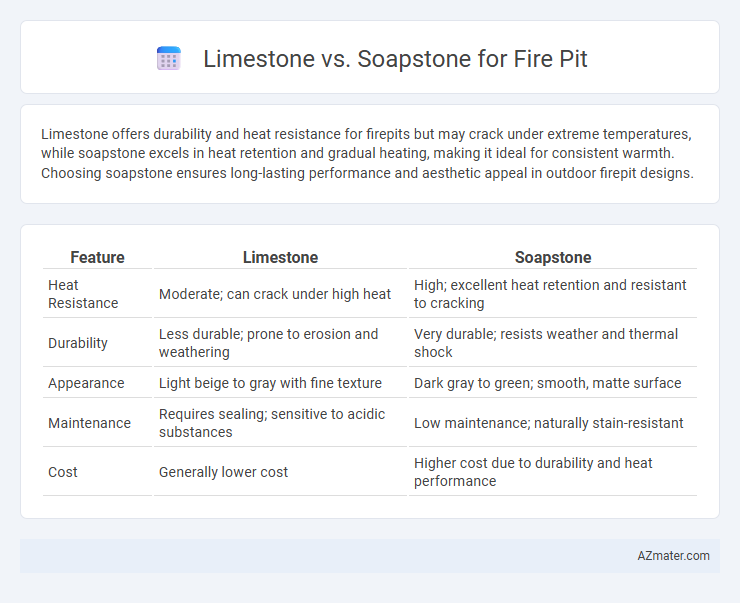Limestone offers durability and heat resistance for firepits but may crack under extreme temperatures, while soapstone excels in heat retention and gradual heating, making it ideal for consistent warmth. Choosing soapstone ensures long-lasting performance and aesthetic appeal in outdoor firepit designs.
Table of Comparison
| Feature | Limestone | Soapstone |
|---|---|---|
| Heat Resistance | Moderate; can crack under high heat | High; excellent heat retention and resistant to cracking |
| Durability | Less durable; prone to erosion and weathering | Very durable; resists weather and thermal shock |
| Appearance | Light beige to gray with fine texture | Dark gray to green; smooth, matte surface |
| Maintenance | Requires sealing; sensitive to acidic substances | Low maintenance; naturally stain-resistant |
| Cost | Generally lower cost | Higher cost due to durability and heat performance |
Introduction to Limestone and Soapstone Firepits
Limestone firepits offer natural durability and a classic, textured appearance that withstands outdoor elements, making them a popular choice for rustic and traditional designs. Soapstone firepits are prized for their exceptional heat retention and smooth surface, providing a sleek, modern aesthetic while efficiently radiating warmth. Both materials provide unique benefits: limestone excels in structural strength, while soapstone balances practicality with elegant heat distribution.
Key Properties of Limestone
Limestone is a durable sedimentary rock composed primarily of calcium carbonate, known for its heat resistance and ability to maintain structural integrity under high temperatures, making it suitable for firepits. Its porosity varies, which can affect durability in outdoor firepit environments, whereas low-porosity limestone offers better resistance to weathering and thermal shock. The natural aesthetic of limestone, with its light color palette and smooth texture, also provides an attractive and functional surface for firepit construction.
Key Properties of Soapstone
Soapstone stands out for its high heat retention and excellent thermal shock resistance, making it ideal for firepits where consistent heat distribution is crucial. Its dense, non-porous structure resists cracking and weathering better than limestone, ensuring durability under varying temperatures. The natural ability of soapstone to absorb and slowly radiate heat enhances both safety and comfort around firepit areas.
Heat Resistance Comparison
Soapstone outperforms limestone in heat resistance, making it a superior choice for firepits exposed to high temperatures. Limestone has a lower melting point and is prone to cracking or discoloration when subjected to direct heat. Soapstone's dense structure and higher thermal tolerance allow it to absorb and distribute heat evenly, enhancing durability and safety around open flames.
Durability and Weather Resistance
Soapstone outperforms limestone in durability and weather resistance, making it ideal for firepits exposed to harsh outdoor conditions. Its dense, non-porous structure resists heat, moisture, and freeze-thaw cycles without cracking or eroding. Limestone, although aesthetically appealing, is more porous and prone to weather-induced damage, reducing its longevity in firepit applications.
Maintenance and Upkeep Requirements
Limestone firepits require regular sealing to prevent water absorption and erosion, as their porous nature makes them susceptible to weathering and staining. Soapstone, on the other hand, is denser and non-porous, needing minimal maintenance and naturally resisting heat damage and moisture without frequent sealing. Routine cleaning with mild soap and water suffices for both materials, but soapstone's durability ensures less frequent repairs and longer-lasting aesthetics in outdoor firepit use.
Aesthetic Differences and Design Options
Limestone offers a natural, earthy appearance with soft, muted colors and subtle texture, making it ideal for rustic or traditional firepit designs. Soapstone features a smooth, dense texture with dark gray to green hues that develop a rich patina over time, enhancing modern and contemporary aesthetics. Both materials provide versatile design options, but limestone's lighter tones contrast with soapstone's deeper shades, influencing the overall visual impact of the firepit.
Cost Comparison: Limestone vs Soapstone
Limestone firepits generally cost less than soapstone due to the stone's abundance and easier quarrying process, making it a budget-friendly choice for outdoor installations. Soapstone, known for its heat resistance and durability, commands a higher price point linked to its density and specialized mining techniques. Comparing costs, limestone offers affordability while soapstone provides long-term value through superior performance and aesthetic appeal.
Environmental Impact and Sustainability
Limestone firepits are made from sedimentary rock that requires energy-intensive quarrying and processing, which can result in a higher carbon footprint compared to soapstone. Soapstone, being a metamorphic rock with excellent heat retention, often comes from regions with stricter mining regulations and tends to have a longer lifespan, reducing the need for frequent replacements. Both materials are natural and reusable, but soapstone's durability and lower extraction impact make it a more sustainable choice for environmentally conscious firepit installations.
Conclusion: Choosing the Best Stone for Your Firepit
Limestone offers excellent heat retention and a classic appearance, making it a popular choice for firepits that prioritize aesthetics and moderate heat resistance. Soapstone excels in durability and superior heat endurance, providing long-lasting performance and heat distribution for intense firepit use. Selecting between limestone and soapstone depends on your desired balance of visual appeal and thermal efficiency for an optimal firepit experience.

Infographic: Limestone vs Soapstone for Firepit
 azmater.com
azmater.com